
The Future Workforce Index: Evolving talent trends in 2025 and beyond
The Future Workforce Index: Evolving talent trends in 2025 and beyond
As the integration of AI across sectors accelerates and business leaders feel competitive pressures mount, they are grappling with growing skills gaps that threaten organizational performance. Traditional employment-centric structures with rigid, pre-pandemic models are failing to meet the evolving demands of the workforce. Upwork, an online marketplace connecting businesses with a global pool of freelance talent, surveyed 3,000 skilled knowledge workers via its Upwork Research Institute and found a significant shift is underway: 28% of skilled knowledge workers now operate as freelancers or independent professionals, seeking greater autonomy, financial control, and meaningful work.
- This shift is reshaping not only careers but also the broader labor market, as freelancers collectively generated $1.5 trillion in earnings in 2024, often out-earning their counterparts who hold traditional full-time roles.
- This trend is poised to accelerate: 36% of knowledge workers who currently hold full-time jobs are considering freelancing, and Gen Z is overwhelmingly choosing independent work.
- Skilled freelancers are proving to be more future-ready than full-time employees, excelling in emerging fields such as AI, software development, and sustainability while embracing continuous learning and self-directed skill development. They are leading the adoption of AI tools, with over half (54%) reporting advanced proficiency and indicating superior adaptability, critical thinking, and problem-solving abilities—key attributes for navigating an AI-integrated workforce.
Although business leaders remain hesitant to embrace nontraditional talent models, Upwork Research Institute research shows that those who leverage this growing talent pool drive higher revenue growth. These findings highlight a growing imperative for businesses: As more skilled workers opt for self-managed, long-term careers centered on continuous learning and skill variety, business leaders must adapt their talent strategies to include these professionals. Failing to do so is to risk widening skills gaps and falling behind in a rapidly shifting world of work.
How is skilled talent evolving?
As competitive pressures intensify and AI technology advances at an unprecedented pace, workforce skills have become a foremost concern for business leaders. Thirty-eight percent of C-suite executives say the gap between available and needed skills will be a major factor impeding their organization’s performance this year—one that the survey shows will have a bigger impact than regulatory changes, leadership misalignment, or shifting consumer demands.
Some of these pressures reflect the stark reality that there are simply fewer skilled workers than there used to be: Populations in many developed countries mean people are aging out of the workforce at increasing rates, and organizational structures that are viewed as too rigid in the post-COVID era are causing other groups to leave voluntarily. Some of this change may be due in part to the fact that the very nature of what it means to be skilled is rapidly changing as AI becomes embedded across functions and organizations and creates new ways of working.
In this new annual report, the Upwork Research Institute explores the question: How is skilled talent evolving? The findings reveal an ongoing and accelerating shift away from the conventional 9-to-5 employment model, signaling a transformation in the way work is structured and performed. In a survey of 3,000 skilled knowledge workers, more than 1 in 4 (28%) work in a freelance or nontraditional work model, opting for greater control over their career, financial future, and ability to pursue work that is meaningful to them.
Skilled knowledge freelance work generated over $1.5 trillion in earnings in 2024, earned by the roughly 20 million workers who performed this kind of work in the United States, according to Bureau of Labor Statistics salary data analyzed by the Upwork Research Institute. Across functions and occupations like writing, creative design, and IT and development, full-time freelancers outearned their full-time employee (FTE) counterparts, earning a median income of $85,000. Skilled moonlighters, who perform freelance knowledge work alongside their full-time jobs, earned $40,000 in addition to their full-time wages. With 78% of skilled freelancers reporting satisfaction with their pay versus just 64% of FTEs, this data suggests people are finding value in reshaping their careers and working outside traditional organizational boundaries.
The Future Workforce Index is The Upwork Research Institute’s flagship report, tracking the rise of skilled freelancers and their impact on the workforce, on the economy, and on business innovation.
Introducing the freelance knowledge worker
Skilled knowledge work performed on a freelance or contract basis differs from gig work in that skilled knowledge workers apply highly specialized expertise toward solving organizational challenges. This expertise is often honed through education, training, and experience. Indeed, more skilled freelancers have post-graduate degrees (37%) than their full-time employee counterparts (20%) and translate this knowledge into the delivery of skilled services (such as computer programming, marketing, creative design, and IT) or professional consulting activities.
However, different skilled freelancers approach and manage their work differently. This research finds that skilled freelancers typically take on one or more of the following personas that indicate different preferences in modes of working (see Figure 1).
Figure 1.
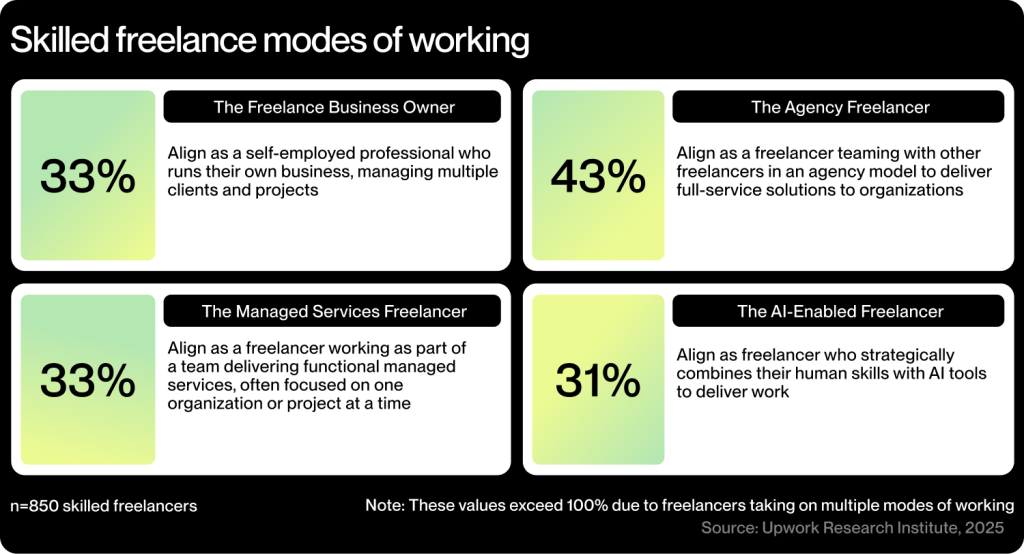
The Freelance Business Owner, representing 33% of skilled freelancers, owns and operates their own business, typically managing a portfolio of different clients and projects simultaneously.
The Agency Freelancer, representing 43% of skilled freelancers, teams up with other freelancers through an agency model that provides end-to-end services to organizations.
The Managed Services Freelancer, representing 33% of skilled freelancers, works as part of a team that provides functional managed services to organizations.
The AI-Enabled Freelancer, representing 31% of skilled freelancers, approaches their work using a combination of their human capabilities and AI-enabled tools. While they are not the only persona using these tools to augment their work, these freelancers specifically design and market their services as a partnership between themselves and AI. This mode of working is on the rise, as 36% of skilled freelancers anticipate working this way in five years.
Across these modes of working, skilled freelancers are finding freedom that traditional full-time employment models don’t allow. These freelancers are motivated by flexibility in their schedule, the ability to be their own boss, and the control they have that allows them to pursue work they feel to be meaningful, all while managing their own development and building a career. Further, these workers are finding the initial value proposition of nontraditional working holds true. The top reasons skilled freelancers started freelancing in the first place—to have flexibility, to be their own boss, and to pursue meaningful work—are the same reasons they continue.
Skilled freelancing is also widespread among knowledge workers at all levels. For instance, executive-level leaders may be surprised to learn how high the chances are that they or someone in their immediate network has freelanced; 63% of C-level leaders say they have at some point in their career. In fact, 42% of CEOs have performed skilled freelance work that is related to their current area of expertise.
The Future Workforce Index: How skilled freelancers measure up
The future is coming fast, and the very concept of being “skilled” is a moving target. According to the World Economic Forum, 39% of worker skills will become transformed or outdated in the next five years. Skilled freelancers lack access to the traditional organizational structures designed to keep employees informed, trained, and relevant. Can they keep up?
To answer this question, the Upwork Research Institute developed the Future Workforce Index by conducting an extensive literature review and validating it with internal subject matter experts. The Index is designed, in part, to determine the readiness of skilled workers of all kinds to take on what’s next across a range of dimensions.
In particular, a future-ready worker is one who has expertise in fast-growing areas, continuously learns and applies new skills, is proficient in using emerging technology like AI to enhance and amplify their work, possesses uniquely human skill sets that are becoming increasingly critical as the workforce shifts to managing and working alongside AI agents, and is motivated and energized to grow their career in a changing world of work.
In many cases, skilled knowledge freelancers are actually outpacing their skilled full-time counterparts in future readiness through self-directed learning, hands-on experiences, and continuous self-development that is not always possible in a traditional organizational setting (see Figure 2).
Figure 2.
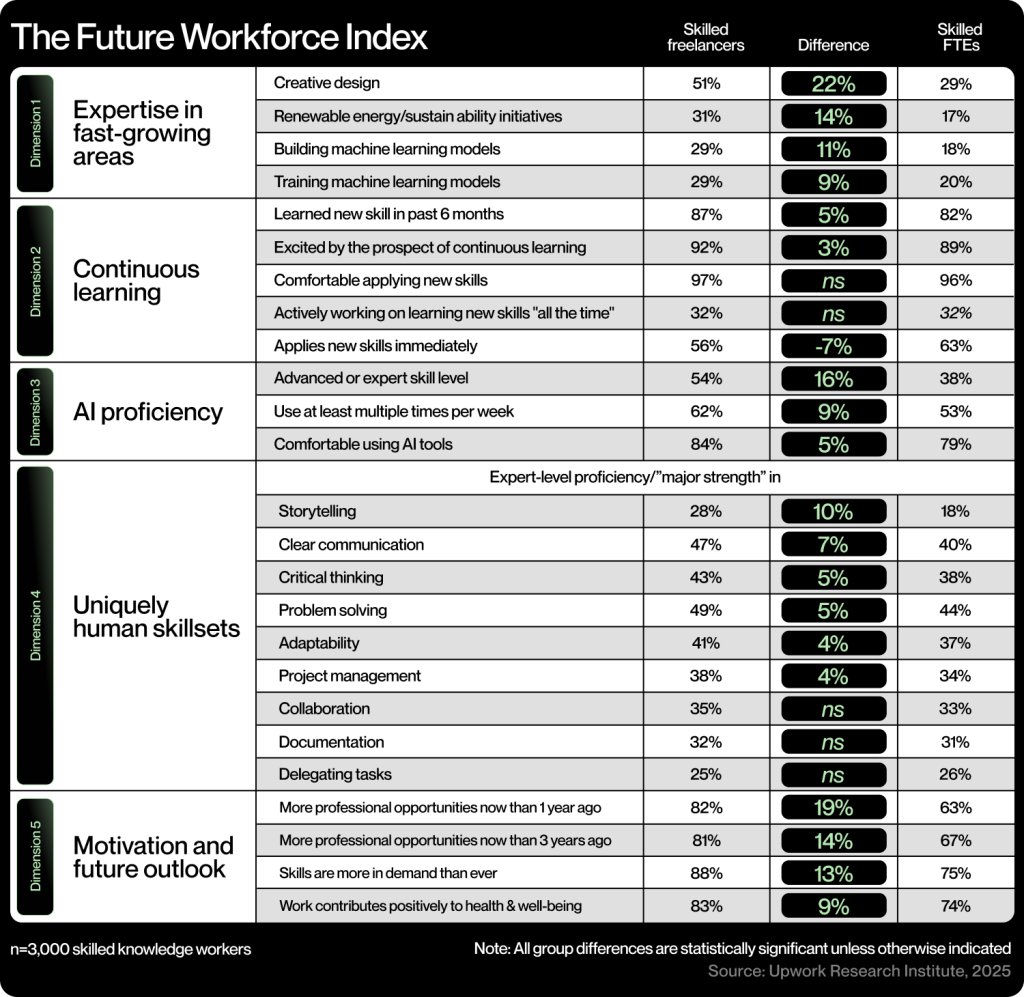
Expertise in fast-growing areas. Although the skills landscape is ever-evolving, it is increasingly clear that certain kinds of work—and people who know how to perform it—will be needed in the future. Technology-related roles such as machine learning specialists and software developers are projected to grow, as are green and energy transition roles such as environmental engineers and experts in renewable energy. Nearly 1 in 3 (31%) skilled knowledge freelancers claim extensive experience in renewable energy and sustainability initiatives, versus just 17% of skilled full-time employees. Twenty-nine percent are experienced in building and training machine learning models, compared with 18% and 20% of full-time employees, respectively. And 35% report extensive experience in software development, versus just 28% of full-time employees.
Continuous learning and skill application. Skilled freelancers and full-time employees are both similarly comfortable learning new skills, and both groups are excited by the prospect of continuous learning within their careers. One in 3 (32%) skilled workers say they are actively working on picking up new skills “all the time.” Unsurprisingly, most (87% of freelancers and 82% of FTEs) say they have learned a new skill in the past six months. The key difference among these workers is in the learning sources available to them. While skilled full-time employees lean more on formal organizational training (54%) and organizationally sponsored development (46%), skilled freelancers are free to pursue a wider variety of formal, experiential, and social learning opportunities, leaning particularly on self-directed learning (64%), formal certification programs (41%), and apprenticeships and mentorships (28% vs. 20% of full-time employees that do the same; see Figure 3).
Figure 3.
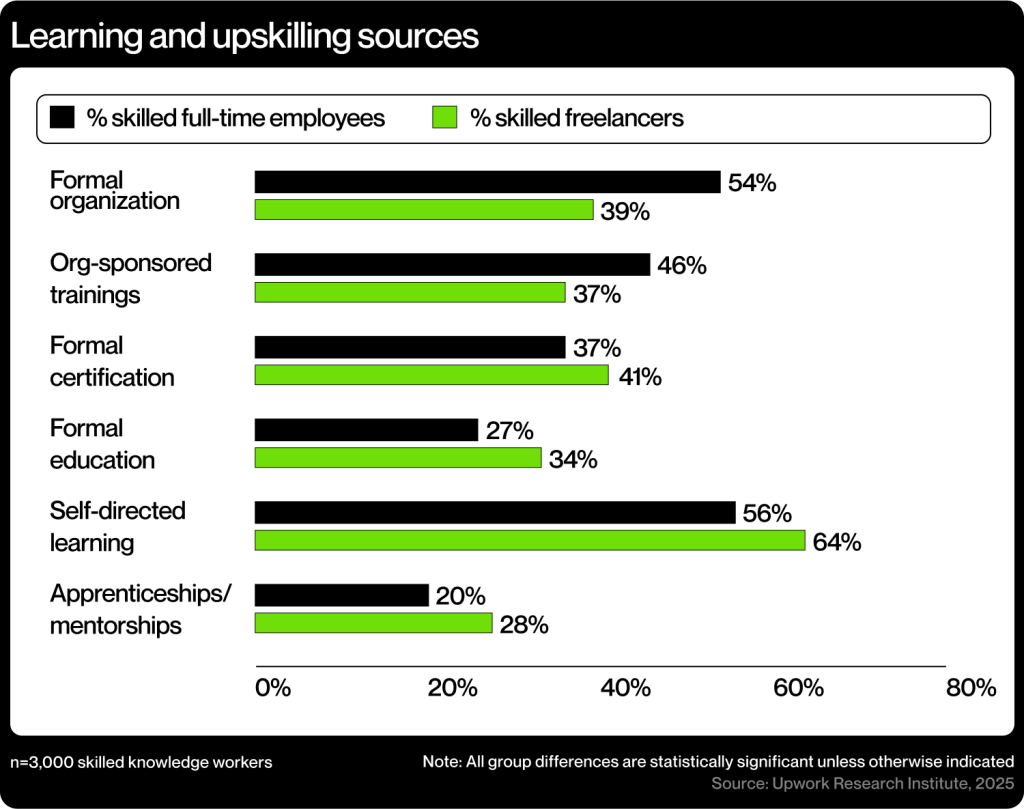
Proficiency in AI. This multimodal approach to learning especially pays off when it comes to using AI tools professionally. Here, skilled knowledge freelancers are well ahead of their full-time employee peers. In short, they are better trained. Fifty-one percent are self-training on AI tools, versus 39% of full-time employees. And although equally likely to be pursuing formal training courses on AI as full-time employees, freelancers are also more likely to be experimenting hands-on and earning formal certifications (see Figure 4). This proactive approach to AI is driven in part by the confidence that these tools will enhance rather than replace their work—84% of skilled freelancers are excited by the prospect of these tools reshaping their services, offerings, and workflows. As a result of pursuing diverse AI learning pathways, over 1 in 2 (54%) skilled freelancers report advanced or expert-level skill in using AI tools for work, and 62% use these tools at least several times per week, versus just 53% of full-time employees.
Figure 4.
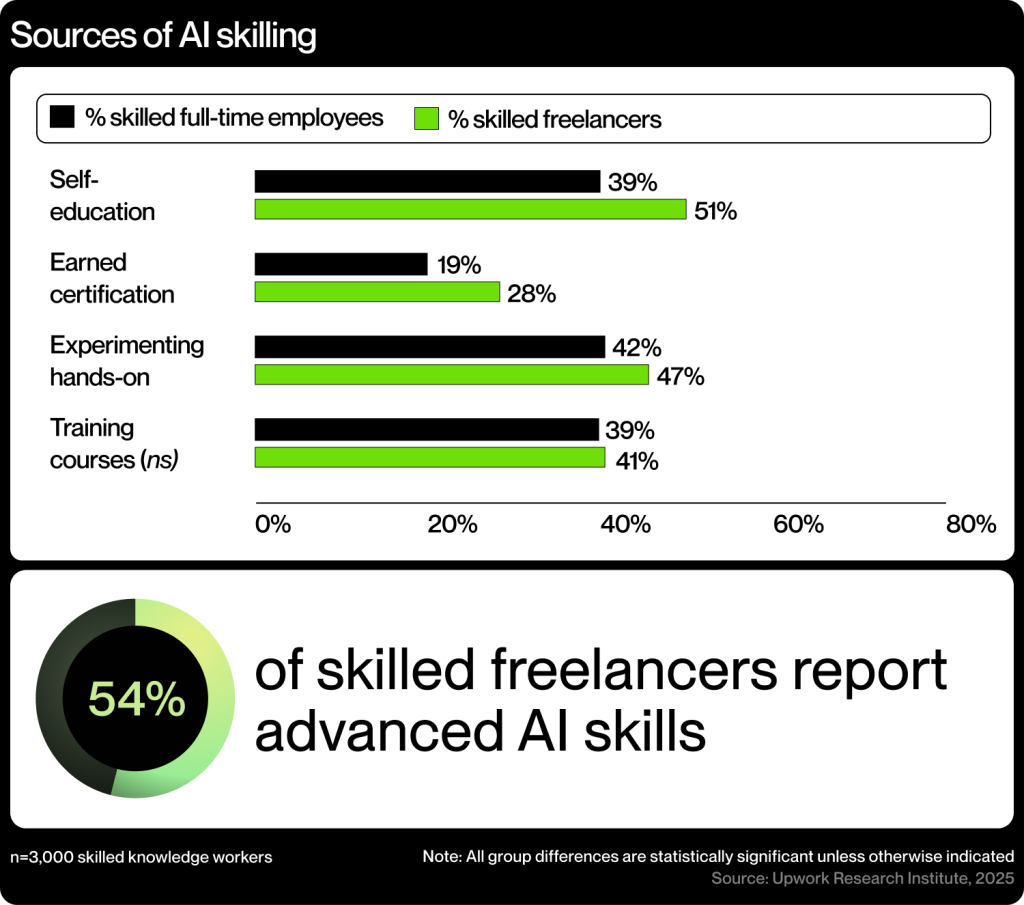
Uniquely human skill sets for an AI agent future. Although technical AI skills are growing in importance, experts agree that humans play a pivotal role in the AI-enabled workplace of the future, as highlighted in a World Economic Forum report released in January. Specifically, as AI agents move from idea to reality, workers increasingly need to manage and work alongside these tools in ways that optimize their output and fully realize their value. To effectively manage AI agents, workers will need to be creative and adaptable, communicate clearly, and think critically. Skilled freelancers reporting these uniquely human skills as a major strength exceed full-time employees across nearly every skill set—notably, more are experts in problem-solving (49% vs. 44% of FTEs), clear communication (47% vs. 40% of FTEs), critical thinking (43% vs. 38% of FTEs), and adaptability (41% vs. 37% of FTEs; see Figure 2).
Motivation and energy to take on what’s next. Eighty-one percent of business leaders acknowledge they are asking their workers to do more than they were a year ago, and 71% of full-time employees report being burned out. Experience in key areas and proficiency in emerging skill sets are important, but just as critical for future readiness are the motivation and outlook to continue being resilient in the face of disruption and change. Today, skilled freelancers are more energized by their work than are FTEs—83% say their work contributes positively to their sense of physical, mental, and emotional well-being. They are also more likely to perceive their professional opportunities as growing, which is unsurprising, considering their comfort with and proficiency in using AI tools. Specifically, as seen in Figure 5, 82% of skilled freelancers believe they have more work opportunities available to them than a year ago, compared to 63% of FTEs. In fact, 88% of skilled freelancers believe their skill sets are more in demand than ever.
Figure 5.
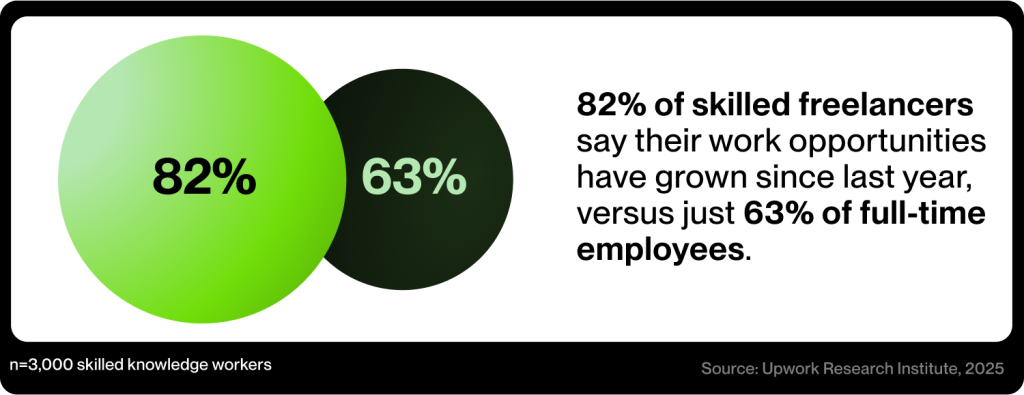
Are business leaders ready?
Despite a growing need for skilled workers, many business leaders are uncomfortable with some of the implications of freelancers working in an alternative talent model. Ninety-five percent of leaders are uncomfortable with the idea that a worker would consider themselves a business owner or “entrepreneur.” Fifty-nine percent are uncomfortable with workers working for other organizations at the same time as their own—in fact, 1 in 2 believe this is “wrong.” Twenty-nine percent say they don’t feel comfortable with workers pursuing self-development on key topics, like AI, outside of the organization’s four walls—despite the limitations of traditional learning and development in keeping pace with rapidly evolving AI tools.
But openness to nontraditional talent pools both widens the net for accessing skilled talent and also grows revenue. An analysis of publicly traded U.S.-based organizations shows that high revenue growth companies—those in the top 25% of year-over-year growth—are more likely to embed nontraditional talent models into the fabric of their organization (see Figure 6). Fifty percent of these companies lean on managed services partners, bringing in external talent to manage key operations. An additional 45% embed skilled freelancers across functions. And 41% leverage mature human-machine AI strategies, in which workers—both freelance and full-time—are encouraged to optimize their human skills alongside AI tools. Work innovators are becoming more antifragile through their unique approaches to integrating people and technology. Companies that continue to rely exclusively on traditional work models, conversely, are positioning themselves more reactively and ultimately falling behind.
Figure 6.
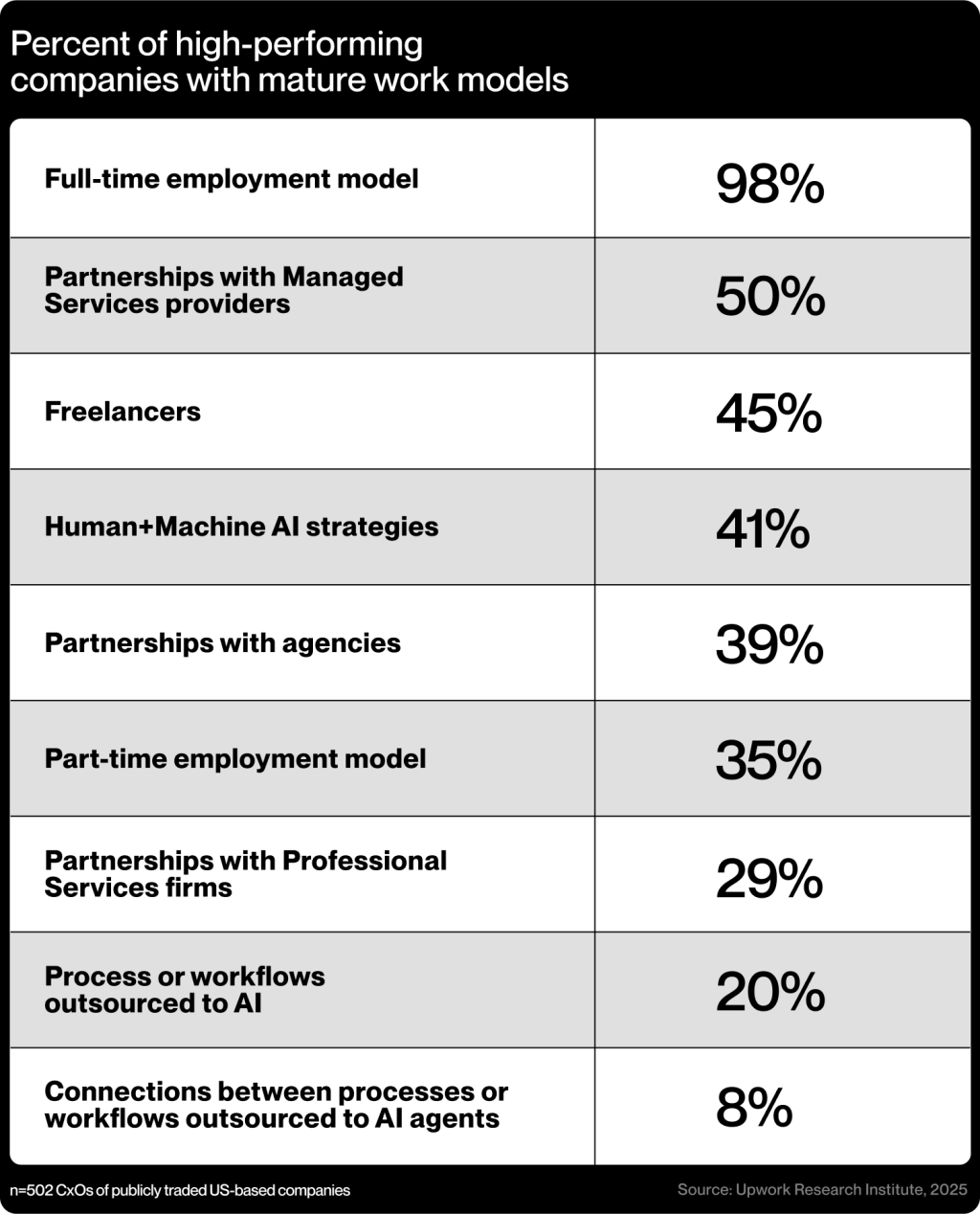
Freelancing is the future of skilled knowledge work
The number of skilled knowledge workers freelancing today is massive—and it’s poised to grow. Over one in 3 (36%) skilled full-time employees are considering freelancing in order to better access professional opportunities (see Figure 7), while only 10% of skilled freelancers are considering moving into a traditional, full-time model. Gen Z workers, who the BLS projects will make up roughly 30% of the U.S. workforce by 2030, are overwhelmingly electing to work as freelancers—53% of skilled Gen Z knowledge workers are already working in this way. Eighty-four percent of skilled freelancers believe the best days are ahead for freelancing in general, and notably, 77% of full-time employees say the same.
Figure 7.
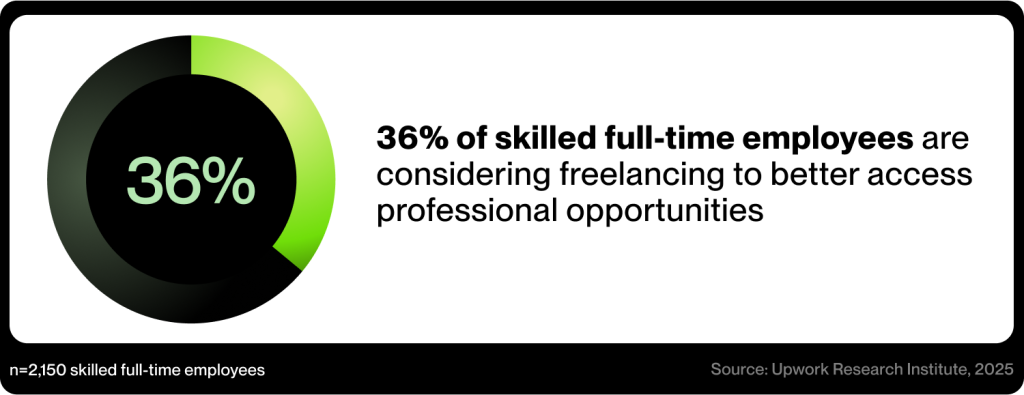
What does this mean for skilled workers? Building a career outside of the confines of the traditional work model has never been more possible, or more advantageous. Skilled knowledge freelancers are at the intersection of innovation, AI, and workforce transformation, and are not only outearning their FTE counterparts today but are also better preparing themselves for the future. While stability was once the promise of full-time employment, a rapidly evolving world of work is revealing this holds true neither for every company nor for every worker. The new promise associated with freelance work is control, self-development, and meaning.
It is important to note that independently built careers are a constantly evolving long game. Two-thirds of skilled knowledge freelancers have been working this way for over three years, and 18% for over 10 years. Key to this is freelancers taking a leading role in their own learning. Indeed, 87% of skilled knowledge freelancers prefer work that helps them improve their current skills or learn new ones versus work that allows them to use the skills they have. When evaluating potential work opportunities, these freelancers determine person-skills fit—the extent to which the work will allow them to apply their strongest skills and provide them with enough skill variety to learn something new—in addition to other factors like flexibility and earning potential.
What does this mean for business leaders? C-suite leaders know they’ve entered a new era when it comes to their organizations. Most realize they cannot rely on traditional approaches to developing products, engaging customers, and creating value. Yet the traditional work model remains the most popular way to structure an organization, with relatively few leaders open to moving away from the norm. Skilled knowledge workers are pushing back. With so many opting out of the traditional organizational structure and instead into lucrative, meaningful, self-managed careers, leaders must ensure that any search for skilled talent includes these workers, or they risk exacerbating skills gaps and falling behind.
Further, it is worth considering the factors driving this opt-out. Skilled workers, whether they currently are, once were, or have never been full-time employees, believe that within organizations their professional and developmental opportunities are relatively limited. The most effective talent models of the future will be those that embrace diverse ways of working, empowering all individuals to contribute their best while removing barriers that hinder learning, innovation and growth.
Methodology
The Upwork Research Institute conducted a survey of 3,000 skilled, U.S.-based knowledge workers from December 2024 through February 2025. Skilled workers were determined by first targeting a representative sample of U.S. workers, and then limiting survey participants to those working above the administrative level across skilled organizational functions and earning hourly earnings above a minimum threshold, as determined by analyzing BLS salary data. The margin of error for these insights is 1.8% at the 95% confidence level.
Skilled freelancers were determined through self reports, with the additional criteria of currently working or having worked as freelancer within the past 12 months. Skilled moonlighters—full-time employees who also perform freelance work on the side—were determined when their freelance work met the same criteria.
In order to extrapolate survey insights to skilled U.S. workers, the BLS category of management, professional and related occupations was used (comprising approximately 71.5 million workers, or 42% of working adults in the U.S. currently). Median self-reported earnings were used to approximate the 2024 earnings of skilled full-time workers, skilled freelancers, and skilled moonlighters (where self-reported earnings were multiplied by the percent of their earnings attributed to freelance work).
The Upwork Research Institute conducted an additional survey of 502 U.S.-based C-level executives with hiring responsibilities within their organizations in December 2024. These executives represented publicly traded organizations in the business and professional services, healthcare and medical, manufacturing, retail and consumer goods, and software and technology industries.
This story was produced by Upwork and reviewed and distributed by Stacker.



